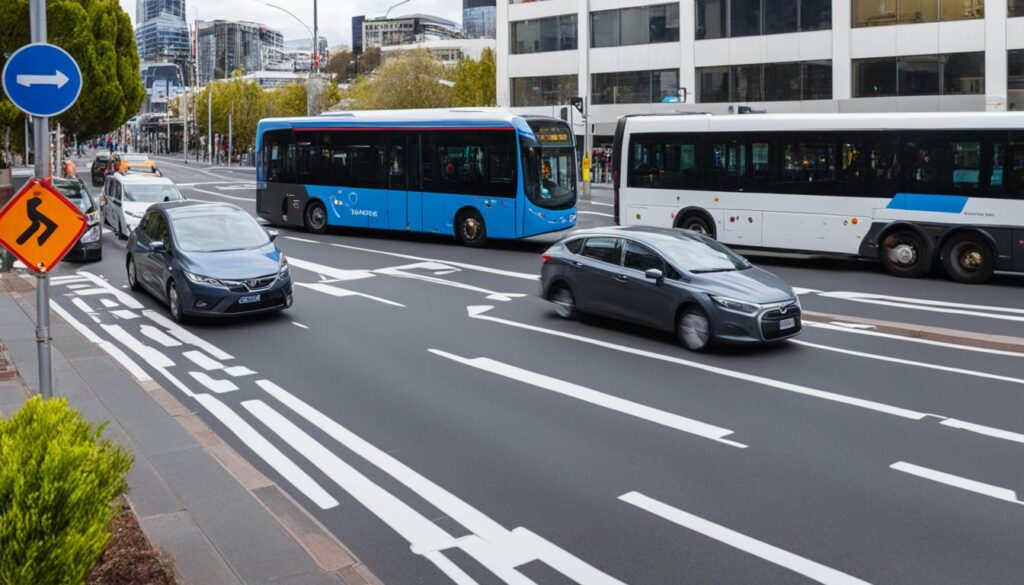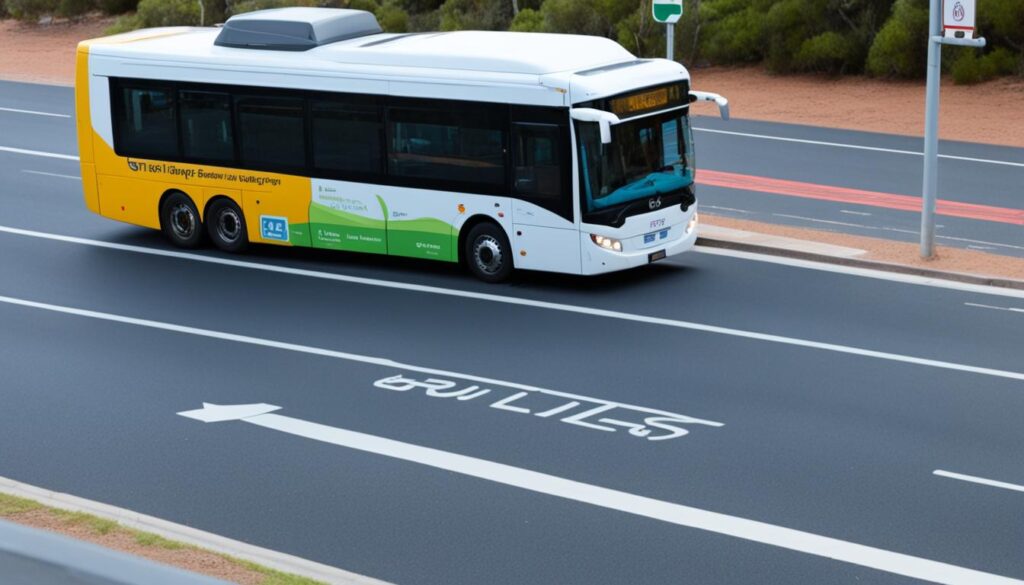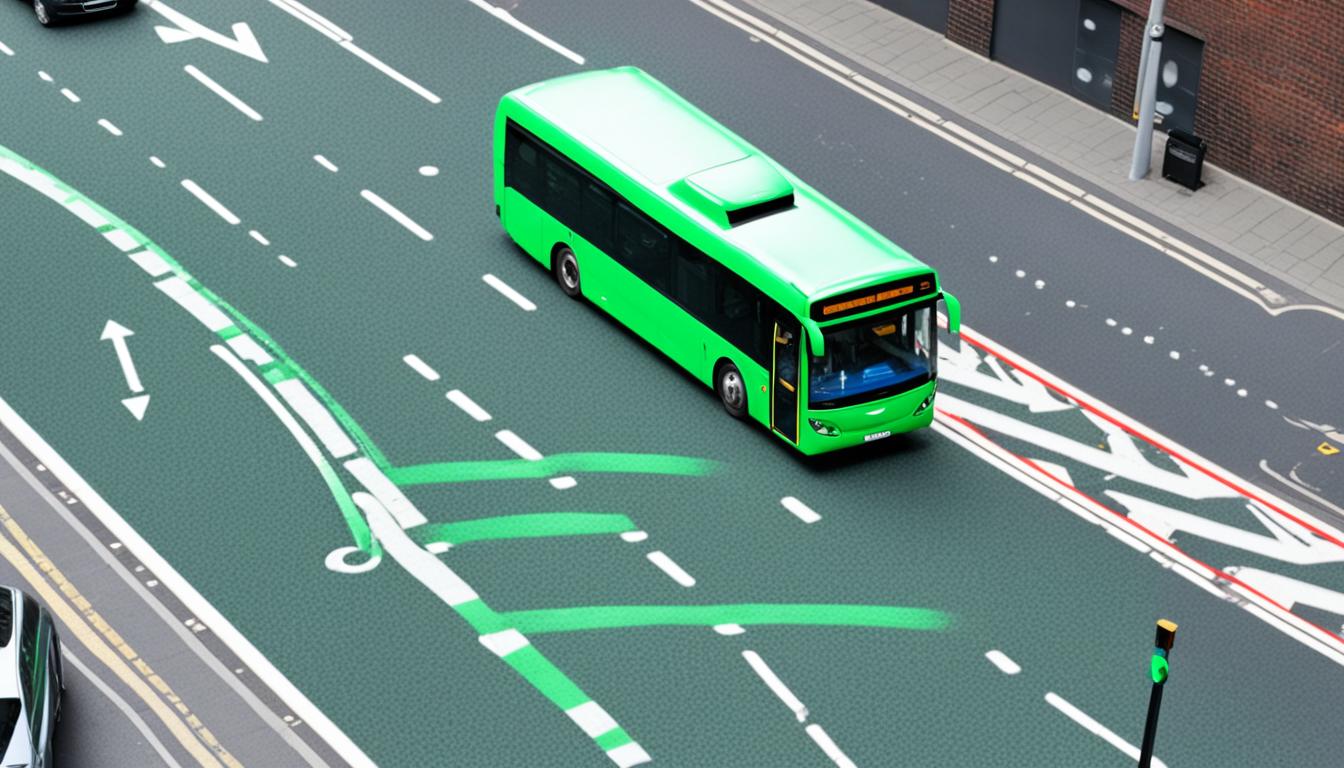In Australia, understanding the rules and regulations surrounding bus lane usage is essential for all drivers. One specific situation that often arises is whether drivers can use the bus lane to overtake a vehicle that is signaling to turn right. Let’s dive into the bus lane rules and find out the answer.
Key Takeaways:
- Using the bus lane to overtake a vehicle signaling to turn right is generally allowed in Australia.
- The bus lane rules apply to all vehicles, including bikes, taxis, buses, and emergency vehicles.
- Specific distance limits often apply when driving in a bus lane.
- Each Australian state has its own bus lane regulations, so it’s crucial to familiarize yourself with the rules in your area.
- Overtaking in a bus lane is only permitted when there is an obstacle in the driver’s traffic lane.
Who Can Use Bus Lanes in Australia?
In Australia, the rules and regulations regarding bus lane usage are specific and distinguish between different types of vehicles. Understanding who can utilize bus lanes is essential for all drivers. Let’s explore the categories of vehicles that are permitted to use bus lanes in Australia:
- Public Buses: Public buses have the primary right to utilize bus lanes across the country. These lanes are designed to facilitate the smooth flow of public transportation and prioritize buses, ensuring efficient transport for passengers.
- Taxis: Taxis are also allowed in bus lanes. This inclusion acknowledges the importance of taxi services in providing accessible transportation options to the public.
- Hire Cars (Limousines): Hire cars, commonly known as limousines, are eligible to use bus lanes as well. This accommodation caters to the needs of passengers who opt for chauffeured services.
- Emergency Service Vehicles: Ambulances, fire trucks, and police vehicles, among others, are granted access to bus lanes. This facilitates their rapid response to emergencies and helps ensure public safety.
- Motorcycles and Bicycles: Motorcycles and bicycles are permitted to use bus lanes, promoting alternative modes of transportation and reducing reliance on private vehicles.
It is important to note that private ride-share vehicles, such as Uber, are not allowed to use bus lanes. These regulations aim to maintain order in traffic flow and prioritize vehicles that provide essential public services.
Understanding who is eligible to use bus lanes in Australia helps ensure compliance with traffic rules and contributes to a safer and more efficient transportation system.
How Far Can You Drive in a Bus Lane?
In general, the bus lane rules allow drivers to drive in a bus lane for up to 100 meters in specific situations. These situations include entering or leaving the road and overtaking a vehicle that is turning right. The distance limit is in place to ensure that the bus lane is used appropriately and doesn’t become congested, allowing for a smooth flow of traffic.
However, it’s important to note that there may be variations in bus lane regulations across different states in Australia. It is crucial for drivers to pay attention to the specific rules and guidelines set by their respective state governments to avoid any violations or penalties.
By adhering to the designated distance limit and being aware of the bus lane regulations in their state, drivers can ensure a safe and efficient use of the bus lane while navigating the roads.
Bus Lane Rules in New South Wales (NSW)
In New South Wales (NSW), the regulations regarding the use of bus lanes are specific and apply to certain types of vehicles. Understanding these rules is essential for all drivers in NSW to ensure compliance and road safety.
Permitted Vehicles
The following vehicles are allowed to use bus lanes in NSW:
- Registered buses
- Taxis
- Hire cars with HC plates
- Emergency vehicles
- Motorcycles
- Bicycles
It’s important to note that private ride-share cars, such as Uber, are not permitted to use bus lanes in NSW.
Driving Distance Limit
When it comes to driving in a bus lane in NSW, there is a specific distance limit that must be observed. Private vehicles can only use the bus lane for up to 100 meters in the following situations:
- Entering or leaving a road
- Passing a vehicle that is turning right
Adhering to this distance limit ensures that the bus lane is used appropriately and helps maintain traffic flow.
“Using bus lanes in NSW is reserved for specific vehicles, including registered buses, taxis, and emergency vehicles. It’s crucial for all drivers to understand the rules and comply with the distance limits to promote safer and more efficient road usage.”
Bus Lane Rules in South Australia (SA)
When it comes to bus lane rules in South Australia, there are specific regulations that govern their use. Similar to NSW, only registered buses, taxis, and emergency service vehicles are permitted to use bus lanes in SA. Ride-share drivers, such as those working for Uber, are not allowed to utilize these lanes.
One of the key aspects of bus lane usage in SA is the distance limit. Drivers can only drive in a bus lane for a maximum of 100 meters. This limit applies when entering or leaving the road, avoiding any obstructions, or passing a car that is turning right. It’s important for drivers to adhere to this limit to ensure the smooth and safe flow of traffic.
To provide a clear understanding of the bus lane rules in South Australia (SA), refer to the table below:
| Vehicle Type | Permitted in Bus Lanes? |
|---|---|
| Registered Buses | Yes |
| Taxis | Yes |
| Emergency Service Vehicles | Yes |
| Ride-share Drivers | No |
Remember, it is crucial to abide by these rules to ensure the safety of all road users. By understanding and adhering to the bus lane regulations in South Australia, drivers can navigate the roads responsibly and efficiently.
Bus Lane Rules in Victoria (VIC)
In Victoria, the rules regarding bus lane usage are specific and designed to keep traffic flowing smoothly and safely. It’s important to understand these regulations to ensure compliance and avoid any penalties or fines.
Who Can Use the Bus Lane?
According to Victorian regulations, only public buses and bicycles are allowed to use the bus lane. Private vehicles are generally not permitted, unless they are entering or leaving the road or passing a vehicle that is turning right.
Distance Limit
Similar to many other states, the maximum distance that a vehicle can drive in a bus lane is 100 meters. This limitation applies whether entering or leaving the road or overtaking a vehicle turning right. It’s essential to adhere to this restriction to ensure that the bus lane is used effectively for its intended purpose.
“Understanding the bus lane regulations in Victoria is crucial for all drivers to ensure the safety and efficiency of our roads.”
| Vehicle Type | Allowed in Bus Lane? |
|---|---|
| Public Buses | Yes |
| Bicycles | Yes |
| Private Vehicles | Only for entering/leaving road or passing turning vehicle |
The table above summarizes the types of vehicles allowed and their permissions for using the bus lane in Victoria.
By following the bus lane rules in Victoria, drivers can contribute to the smooth flow of traffic and ensure the safety of all road users. Remember to always stay informed and be vigilant while driving, respecting the rules and regulations set in place.
Bus Lane Rules in the Australian Capital Territory (ACT)
The Australian Capital Territory (ACT) has specific regulations regarding the use of bus lanes to ensure smooth traffic flow. These rules apply to various types of vehicles, including public buses, motorcycles, bicycles, taxis, hire cars, and emergency service vehicles. Understanding the bus lane rules in the ACT is essential for all road users.
According to the bus lane regulations in the ACT, there is a distance limit for driving in a bus lane. This limit extends to 100 meters and is applicable when vehicles are entering or leaving the road or passing an obstacle, such as a car turning right.
The ACT’s approach to bus lanes aims to provide a balance between improving public transportation efficiency and maintaining safety on the roads. By allowing an extension of bus lane usage to various types of vehicles, the ACT encourages alternative transportation methods and reduces traffic congestion.
Benefits of Bus Lanes in the ACT:
- Improved public transportation efficiency
- Reduced traffic congestion
- Promotion of alternative transportation methods
- Enhanced road safety
By incorporating bus lanes into the road network, the ACT facilitates the smooth flow of traffic and enables public transportation to operate more effectively. This not only benefits commuters but also contributes to a sustainable and eco-friendly transportation system.
The use of bus lanes in the ACT is integral to creating a well-connected and efficient transport network that caters to the needs of both residents and visitors. By providing dedicated lanes for buses, motorcycles, bicycles, taxis, hire cars, and emergency service vehicles, the ACT prioritizes the advancement of public transportation while maintaining high standards of road safety.
Understanding and adhering to the bus lane rules in the Australian Capital Territory (ACT) is essential for all drivers. By obeying these rules, drivers can contribute to smoother traffic flow, minimize congestion, and ensure a safer road environment for all.
Bus Lane Rules in the Australian Capital Territory (ACT)
| Vehicle Type | Permitted in Bus Lanes |
|---|---|
| Public Buses | Yes |
| Motorcycles | Yes |
| Bicycles | Yes |
| Taxis | Yes |
| Hire Cars | Yes |
| Emergency Service Vehicles | Yes |
Bus Lane Rules in Tasmania (TAS)
In Tasmania, drivers must adhere to specific bus lane rules and regulations. These rules determine when and how drivers can use the bus lane to ensure safe and efficient traffic flow. Here are the key guidelines for driving in bus lanes in Tasmania:
Who Can Use the Bus Lane?
The bus lane in Tasmania is primarily reserved for registered buses, taxis, and emergency service vehicles. These vehicles have permission to use the bus lane to navigate through traffic more efficiently. Additionally, bicycles are also allowed in the bus lane to promote sustainable transportation.
When Can You Drive in the Bus Lane?
Drivers can drive in the bus lane for up to 100 meters in specific situations. These include:
- Entering or leaving the road
- Avoiding an obstacle, such as a car turning right
When encountering these scenarios, drivers can utilize the bus lane as a means to safely navigate the road and continue their journey.
Bus Lane Rules for Registered Buses, Taxis, and Emergency Vehicles
Registered buses, taxis, and emergency service vehicles have certain privileges when using the bus lane. These privileges allow them to provide efficient transportation services and respond to emergencies promptly.
Bus Lane Rules for Bicycles
Bicycles are permitted to use the bus lane in Tasmania. This allows cyclists to travel safely and efficiently, promoting active transportation and reducing traffic congestion.
| Vehicle Type | Permission to Use Bus Lane |
|---|---|
| Registered Buses | Yes |
| Taxis | Yes |
| Emergency Service Vehicles | Yes |
| Bicycles | Yes |
By following these bus lane rules, drivers can ensure the smooth and efficient flow of traffic, while also maintaining the safety of all road users.

Bus Lane Rules in the Northern Territory (NT)
Interestingly, the Northern Territory does not have designated bus lanes like other states in Australia. However, there may be certain areas that function similarly to bus lanes, even though they are not officially classified as such. These designated areas typically prioritize public transportation and allow buses to travel unimpeded by regular traffic.
When driving in the Northern Territory, it’s essential to pay attention to specific signage and regulations regarding bus-only areas. These signs will indicate where buses have the right of way and cars should yield. Adhering to these instructions ensures the smooth flow of traffic and the safety of all road users.
In the absence of official bus lanes, it’s crucial for motorists in the Northern Territory to have a good understanding of general traffic rules and guidelines. By staying informed and observant, drivers can navigate these designated areas with caution and respect for other road users.
Bus Lane Rules in Western Australia (WA)
In Western Australia, drivers must adhere to specific rules and regulations when using bus lanes. These rules are designed to ensure the smooth flow of traffic and the safety of all road users.
Distance Limit
When driving in a bus lane in Western Australia, there is a distance limit of 100 meters. This limit applies to all vehicles, including private vehicles. Drivers should only use the bus lane for up to 100 meters when entering or leaving the road or to overtake a vehicle that is turning right.
Private Vehicle Access
Unlike other states, private vehicles are allowed to use the bus lane in Western Australia during specific times. Typically, this access is granted outside of peak hours to help alleviate traffic congestion. However, drivers should be aware of the designated times and ensure they only use the bus lane during those periods.
Bus Lane Locations
Most of the bus lanes in Western Australia are concentrated in the city of Perth. These lanes are strategically placed to help improve public transportation efficiency and reduce travel times for buses and other permitted vehicles.

By understanding and following the bus lane rules in Western Australia, drivers can contribute to a safer and more efficient traffic environment. It’s important to stay updated with any changes or additional regulations that may be implemented in specific areas to ensure compliance and a smooth driving experience.
Rules for Overtaking in a Bus Lane
When it comes to overtaking in a bus lane, there are specific rules and regulations that motorists need to be aware of. According to bus lane regulations, overtaking in a bus lane is only permitted under certain circumstances.
This rule applies when there is an obstacle in the driver’s traffic lane, such as a car waiting to turn right. In such cases, vehicles are allowed to pass the turning vehicle from the left using the bus lane. This not only ensures smoother traffic flow but also helps to avoid congestion on the roads.
However, it’s important to note that there is a distance limit for overtaking in a bus lane. The same general rule of 100 meters applies. This means that motorists should complete the overtaking maneuver within this specified distance to comply with bus lane rules.
By following these rules regarding overtaking in a bus lane, drivers can maintain safety on the roads while utilizing the bus lanes effectively to navigate through traffic.
Whether you’re a seasoned driver or a new one, understanding these rules is crucial to ensure a smooth and efficient flow of traffic. By adhering to the bus lane regulations and using them responsibly, motorists can contribute to safer and more efficient journeys for everyone.
Conclusion
Having a clear understanding of the bus lane rules is essential for all drivers in Australia. One important rule to note is that drivers are allowed to use the bus lane to overtake a vehicle signaling to turn right. However, it is crucial to follow the specific guidelines and distance limits set by each state. By doing so, drivers can safely navigate bus lanes and utilize them to pass turning vehicles.
Remember that bus lane rules may vary depending on the state you’re driving in. Familiarize yourself with the regulations in your specific location to ensure compliance and avoid any potential penalties. Adhering to these rules not only ensures a smooth flow of traffic but also contributes to the overall safety of all road users.
Using the bus lane to pass a turning vehicle is an effective and efficient way to keep the traffic moving. However, it’s important to do so responsibly and only when it is safe and allowed by the bus lane rules. By following these guidelines, drivers can make the most of bus lanes and ensure a smooth driving experience for everyone on the road.
